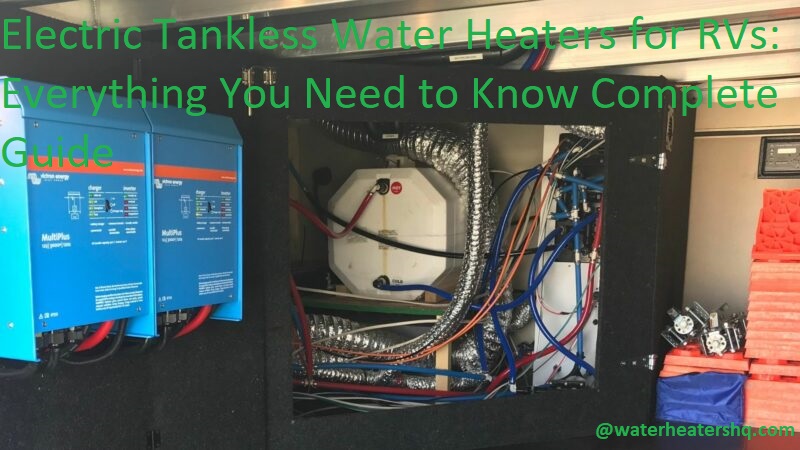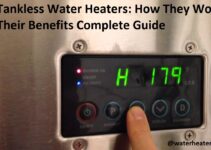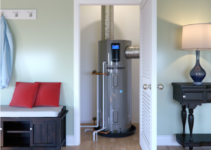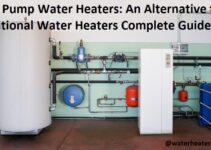Do you long for a hot shower on your RV trips, but worry about its energy efficiency? Get ready to become an avid supporter of tankless water heaters!
This comprehensive guide will explain all you need to know about electric tankless water heaters for RVs and their benefits. You’ll never have to sacrifice your comfort while saving money.
Tankless water heaters provide a great alternative to traditional RV water heating systems. This complete guide will give you everything you need to know if you’re considering changing over to a tankless system. Tankless water heaters are compact, fast, and efficient. They quickly heat up your water on demand and only use power as you need it. This means that tankless units can greatly reduce related energy costs over traditional gas-fired or electric-storage tank systems. Tankless systems are also much more reliable than any other type of RV water heating system and feature long life-cycles that require less attention from owners than standard RV water heater units.
Tankless systems are a popular choice for those who live in their RVs full-time or for travelers who want a hassle free hot-water experience when out on the road. These models require careful research and setup, however, and learning about the different models available is an essential step before committing to making the switch. In this guide we’ll explore the history of tankless water heating technology and how it works, how to choose the right model for your RV, how they’re installed, their pros & cons in comparison to other types of state heaters, tips on how to maintain them properly – as well as some additional info on troubleshooting common issues with these units.
Explanation of electric tankless water heaters
An electric tankless water heater is an appliance that heats water on demand. That is, it doesn’t use a reservoir or tank for storing hot water, but instead heats it when needed. This technology can be used to help reduce energy waste and increase efficiency in RVs. While this technology has been around for decades, capacities have increased in recent years and they are now a viable option for use with recreational vehicles such as cars, campers, and boats.
Electric tankless heaters are typically more compact than other types of heaters and provide hot water on demand without having to wait for the water to warm up. Additionally, they take up significantly less space than other systems which can be appealing in limited RV spaces.
This guide will explain why an electric tankless water heater might be a good choice for an RV and provide a complete overview of the different types available on the market today. It will also address some issues to consider when selecting the right product such as cost, safety features, installation requirements, maintenance concerns and more.

Benefits of electric tankless water heaters for RVs
Electric tankless water heaters for RVs offer several advantages compared to traditional gas-powered or electric tanked water heaters. These benefits include:
Energy Efficiency: Electric tankless water heaters are more energy efficient than their traditional counterparts. Since they don’t hold and store hot water, they produce hot water on demand and only when it’s needed. This reduces wasted energy, resulting in long-term cost savings.
Endless Hot Water Supply: With an electric tankless water heater, you’ll never experience a cold shower due to the lack of hot water. This type of heater produces an endless supply of hot water and is capable of providing multiple showers at one time without ever running dry.
Space Savings: Tankless electric RV heaters are much more compact than their traditional counterparts, taking up barely any room in your vehicle. This extra storage space can be used for other items, making them ideal for small RV layouts or those who need to maximize every inch of usable space.
Cost Benefits: Since electric tankless RV heaters don’t require as much energy as their traditional counterparts do, they’re usually cheaper to operate over the long run and may provide safety benefits such as avoiding potentially dangerous gas leaks or explosions associated with gas powered RV tanks models which use propane or natural gas.
Factors to Consider When Choosing an Electric Tankless Water Heater for Your RV
Before investing in an electric tankless water heater for your RV, there are several factors you must consider. Choose the wrong heater and you could end up with reduced hot water capability, high energy bills and even safety hazards. Carefully research before making a decision to ensure the best value and performance for your recreational vehicle.
When choosing a power source for an electric tankless water heater, your RV must be able to provide at least 30 amps of service. Many RVs only supply 20-30 amps so be sure to check the specs before selecting a model. Additionally, most tankless models require three-wire service (hot, neutral and ground) unlike some electric systems that use two-wire service that includes only two wires—hot and neutral).
Further considerations include heater size, features such as temperature control and flame management, minimum flow rate requirement of the device and any available compatibility with additional controllers or flush kits. Other important factors are water pressure requirements in both minimums per square inch (PSI)and gallons per minute (GPM). Selecting models with higher output capacities allow you to use more applications from showers to kitchen sink faucets at one time without reducing pressure or having to constantly wait for warm water. This gives you maximum improvement in convenience as well as providing better performance reliability for years of worry free enjoyment of your travels!
Water usage needs
Part of correctly determining the best tankless water heater for your RV involves considering how you will use it. The two key factors to consider are the number of people living in your RV, and the variety of uses you will have for hot water, from showering and washing dishes, to laundry. A larger household would likely be better served by a higher capacity unit, whereas an individual or smaller home may be able to use a lower capacity model.
It is also important to think about the flow rate; this measures how much water is delivered at the desired temperature. For example, if you need substantial hot water for a shower or long washing cycle in a low-flow system (i.e., one with a lower flow rate) then it may take some time as the temperature is adjusted and maintained throughout delivery. Selecting a unit that offers an ample flow rate is important if you want plenty of hot water quickly without depleting pressure in other faucets throughout your rig while this activity is taking place.
Power requirements
When considering the power requirements for an electric tankless water heater for your RV, it’s important to look at the total wattage of the unit, as well as any additional power requirements you may have. Electric tankless water heaters require anywhere from 1000-5500 watts of power, depending on size and model. For RVs, it is recommended that you select a unit which draws between 2000-3000 watts of power. This will give you enough hot water for your basic needs without draining your RV’s battery too quickly.
It’s also important to check that your RV has the necessary electrical outlets (220V/30A) and suitable wiring to ensure safe installation and operation of the electric tankless water heater. Additionally, you should look into other energy efficiency measures such as installing an energy efficient pump to ensure that your RV battery does not get drained due to high energy waste when using the tankless water heater.
Installation of Electric Tankless Water Heaters in RVs
Installing an electric tankless water heater in your RV is not an overly complex process, however it still can take some time. The first step should be to familiarize yourself with the installation instructions and diagrams provided by the manufacturer in order to ensure correct setup of your new unit. It is important that you follow these instructions carefully, since if the unit is installed incorrectly it could result in safety issues and improper functioning.
Before starting, begin by shutting off the power supply to your RV and determining a suitable location for installation. When positioning your unit, keep in mind any restrictions that may be imposed by the space available within the RV. For example, will the current electrical system supply enough power needed to operate a tankless water heater? In addition, ensure that there is enough space surrounding the unit for proper ventilation once it is installed.
Next, mount and secure your electric tankless water heater using appropriate mounting hardware according to manufacturer instructions before beginning any wiring tasks. Depending on brand and model of water heater you purchased, additional components such as temperature controllers might need to be installed at this point as well. Take this time to also double check that all required wiring connections are present before proceeding further.
Finally, reinstall any protective panels you may have taken off during installation process before switching on power once again as well as rechecking all electrical connections for accuracy. Now you are ready to enjoy hot water on demand!
Tools and materials needed
Before beginning any tankless water heater installation for an RV, it is important to have the necessary tools and materials available before starting. Some of the items you will need include:
– Tankless water heater designed for RV use
– Wrenches, WD40, start wrench, adjustable pliers
– Hammer or rubber mallet
– Level
– Lock washers and nuts
– Pipe sealant
– Hacksaw or hole saw
– Tube cutter
– Teflon tape
– Thread sealant
– Needle nose pliers
Most of these items can be found at a hardware store or home improvement center, though some specialized parts and tools may need to be ordered. Make a checklist of the items needed before beginning installation to ensure everything you need is easily accessible. With all the components ready at hand the process of installing a tankless water heater will go much smoother for an RV.

Steps to install an electric tankless water heater
Installing electric tankless water heaters in an RV can be a straightforward task. Depending on your trailer and chosen electric tankless water heater, there should be minimal difficulty and disruption. To help you start your installation process, here is a checklist of the main steps:
- Choose the right location: To ensure optimal efficiency and performance, you will need to choose the right location for your electric tankless water heater. Carefully measure each object, access point and appliance near where you’re installing it, to ensure ease of wiring, plumbing and ventilation.
- Clear any obstructions: If there is anything blocking your intended spot for installation (e.g., cupboards or appliances) make sure to clear them out as much as possible before beginning the installation process. This will provide maximum space for maneuvering the components when it comes time for assembly.
- Assemble parts: Now that you know the size requirements for each component of your electric tankless water heater (including wires, pipes and venting), begin assembling everything together according to the product instructions in order to fit them into your trailer’s layout correctly.
- A professional may be required: Electric tankless water heaters have both electrical components and plumbing fixtures which can require experience by a professional before use; contact an individual who is certified by relevant state or local codes prior to installation if needed.
- Test all connections: Ensure that all connections are secure prior to connecting power sources to prevent any leaks or hazards from occurring while using your new system; check with the manufacturer instructions if uncertain concerning any part of this step before proceeding further with initializing power supply.
Maintenance and Care of Electric Tankless Water Heaters for RVs
Even the highest quality electric tankless water heaters must be cared for and maintained correctly to ensure they last as long as possible. Proper maintenance helps extend the life of your unit and can help prevent damage due to mineral buildup and corrosion. Here are some steps you can take to ensure your electric tankless water heater remains in optimal shape:
- Regularly clean the outside of the unit with a mild detergent. Use an old toothbrush or soft bristle brush to reach hard-to-reach places such as corners and crevices. This will help prevent dirt, mold and mildew from accumulating on the unit’s exterior, thereby keeping it looking newer for longer.
- Flush the unit out regularly to remove mineral deposits from its inner workings. This can be done easily by running a few cups of white distilled vinegar through it every few months or so, depending on how heavily you use your RV’s water heater.
- Test your unit just like you would test other RV appliances, such as air conditioners or generators, at least once per year (before heading out on long trips). Check for any signs of corrosion, leaks or other forms of damage that may have occurred during disuse over winter months. If all is well with your system but it still hasn’t been performing optimally, consider having it professionally serviced by a technician that specializes in RV plumbing repairs like these electric tankless water heaters for RVs before embarking on long trips away from home base.
Following these simple tips will help extend the life expectancy of your electric tankless water heater while keeping it trouble free and efficient!
Cleaning and descaling
Regular cleaning and descaling of your electric tankless water heater for RVs is important in order to maintain its performance. Mineral buildup can occur inside the unit when hard water passes through it, especially in urban areas where high levels of calcium and magnesium are present in the municipal supply. This buildup can reduce the efficiency of your electric tankless water heater, shorten its lifespan and impair its ability to heat up the cold water passing through it. It’s important to act quickly when you notice any difficulty with hot water production.
Your electric tankless water heater manufacturers may have specific recommendations for descaling or cleaning procedures – check your user manual or contact customer service if you’re unsure about what steps to take. Generally speaking, it’s a good idea to flush out the system once a year with a special cleaner designed for tankless heaters – such as vinegar or descaling solution — to remove any built-up mineral deposits. Make sure to read all instructions carefully and wear protective gear during the process.
Checking for leaks and other problems
Before you start to use your electric tankless water heater, it’s important to make sure there are no leaks or other problems. A few simple steps can help you identify and fix any issues before they cause permanent damage.
First, inspect all connections to the water heater for any leaks or signs of corrosion. Make sure all hoses are properly secured and tighten up any loose connections with a pair of pliers. It’s also important to check the pressure relief valve (sometimes referred to as the T&P valve) for any signs of leaking or blockage. This valve should be inspected once a month and replaced if needed.
Next, inspect your water heater for any sediment buildup on the heating element or inside the unit itself. This can lead to performance issues and eventually cause permanent damage, so it’s important to clear away any sediment regularly; if necessary, you can contact a professional plumber for assistance in safely disposing of the sediment buildup.
Finally, it is essential that you make sure your electricity supply is strong enough for your electric tankless water heater; an insufficient electrical current can lead to performance problems or even potential fire hazards!
Replacing parts
- Replacing parts: Maintenance on tankless water heaters is relatively easy and requires very little special tools or supplies. Over time, some interior components may become damaged or wear out due to continuous usage. There are a few common replacement parts that may need to be purchased for any tankless water heater –
- Inlet/Outlet Nipples: These parts connect the unit to the RV plumbing system, and attach directly to the front of the unit.
- Dip Tube: This part sits inside of the thermostat and functions as an extra place for colder water to enter while hot water exists at the bottom of the tank.
- Thermostat: The thermostats are in charge of controlling water temperature levels using an adjustable knob.
- Heating Element: The heating element heats up cold incoming water and turns it into hot water with its internal electrical current.
- Pressure Relief Valve: This valve helps regulate pressure within a sealed system and releases pressure when needed, ensuring safety precautions are met when working with electricity and plumbing systems together.
It is important to note that all parts should come from an approved supplier, who will also provide installation instructions when needed. When all else fails, contacting customer support services from your manufacturer can help resolve any outstanding issues you may have with your tankless water heater and help you identify which specific parts need replacing for safety reasons.

Conclusion
In conclusion, electric tankless water heaters are a great option for RVs, especially if you need a reliable hot water source while on the move. They offer a more efficient and economically feasible solution than traditional tanked models that can require regular maintenance and upgrades.
With modern advances in technology, electric tankless water heaters are now available with programmable digital controls with LED displays that allow you to customize the temperature of your hot shower at the touch of a button. They also feature low wattage consumption so it’s easier to find alternative sources of power when necessary, like solar panels or batteries.
No matter what your lifestyle requires in terms of hot water, electric tankless models offer an affordable and enjoyable alternative to hard-to-maintain tank systems.
FAQ’S
What can go wrong with a tankless water heater?
Some common issues that can occur with a tankless water heater include inadequate hot water flow rate, mineral buildup, air flow issues, and electrical problems.
What is the lifespan of an electric tankless water heater?
The lifespan of an electric tankless water heater is typically around 20 years.
Do electric tankless water heaters use a lot of electricity?
Electric tankless water heaters can use a significant amount of electricity, especially if they are not sized correctly for the household’s hot water needs.
Is it worth switching to electric tankless water heater?
Whether it is worth switching to an electric tankless water heater depends on factors such as the household’s hot water needs, energy usage patterns, and budget.
Which is better tankless water heater or electric water heater?
Tankless water heaters can be either electric or gas-powered, so it depends on the specific type of comparison being made. Generally, tankless water heaters are more energy-efficient than traditional storage tank water heaters.
What’s the difference between electric water heater and tankless water heater?
An electric water heater stores hot water in a tank and constantly heats it, while a tankless water heater heats water on demand and does not have a storage tank.
What size tankless water heater do I need for an RV?
The size of a tankless water heater needed for an RV depends on the RV’s hot water needs and usage patterns. It’s best to consult a professional for a proper sizing recommendation.
What is the best RV tankless water heater?
There are several highly rated tankless water heaters for RVs, including the Eccotemp L10, Girard 2GWHAM, and Camplux 5L.
How many amps does a tankless water heater use in an RV?
The number of amps used by a tankless water heater in an RV depends on the unit’s wattage and voltage. A typical electric tankless water heater for an RV may use 30-50 amps.
Do tankless water heaters burst?
Aside from the concern about carbon monoxide, a tankless water heater is a very safe piece of equipment. Because there is no tank which can overheat or experience a massive spike in pressure, a tankless system doesn’t have the danger of bursting or exploding.
See Also:
- Best power vent water heater
- Best propane tankless water heater
- Best solar water heater
- Best tankless water heater
- Best under sink water heater


